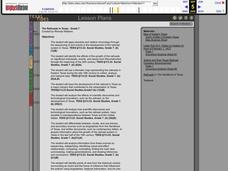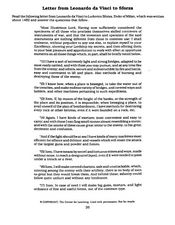Curated OER
Real-Life History: Looking at Our Community
Spend several days with your class exploring local history. Learners brainstorm and categorize sources of historical information as primary or secondary; collect and present artifacts from family/community; construct a definition of...
Curated OER
Can you Prove it?
Tenth graders examine how primary source documents help authors and museum curators interpret historic events. In this social studies lesson, 10th graders research primary source documents. Students create a powerpoint to...
Curated OER
Ancient Babylon
Authenticate an ancient civilizations study by having historians analyze primary source artifacts. After examining an image of a Babylonian king votive statue, pupils read a short background context. They then answer 3 questions based on...
Curated OER
The Impact of the Civil Rights Movement
Deepen understanding of the Civil Rights Movement with this collection of primary documents. This resource contains 22 video transcripts about desegregation, voting rights, black power, Dr. Martin Luther King Jr., and more. You might...
Curated OER
Many Passages: The Voyage of the Slave Ship Brookes
Examine three perspectives of the slave trade - captain, sailor, and captive - through this collaborative analysis activity. Small groups study one perspective with a primary source to analyze. They discern what is a historical fact and...
Curated OER
The Railroads in Texas
Seventh graders differentiate between, locate, and use primary and secondary sources, such as biographies from the Handbook of Texas. They analyze the effects of scientific discoveries and technological innovations, such as the railroad,...
Curated OER
Analyzing "Do Not Tax the Colonies"
In this primary source research worksheet, students examine a copy of "Do Not Tax the Colonies," (not included) and respond to 6 short answer questions regarding its content.
Curated OER
Chocolate Chip Cookie Mining
Students explore nonrenewable energy resources. In this coal lesson, students investigate how coal is formed and how it is used as a source of energy. Students mine for "coal" using toothpicks and chocolate chip cookies.
Curated OER
Solar Car Races: Build and retrofit for speed
If you have solar car kits for your junior high schoolers, they can experiment with photovoltaic cell angle, light intensity, and aerodynamic design to discover what makes their car move more quickly. This is a classic activity to use...
Curated OER
Examining Jesus' Teachings
Simplify your study of Christianity with this "back to the basics" activity. Scholars examine a primary source excerpt from the Gospel according to Luke and consider Jesus' teachings. They assess which other belief system has similar...
Curated OER
Revolution of 1848 - Alexis de Tocqueville
Document-based questions are a great way to increase understanding of a primary source document or prepare learners for a class discussion. Here, they'll read an excerpt from Alexis de Tocqueville's speech regarding the revolution of...
Curated OER
Legacy of the Dust Bowl: Dust Storm Media 1930s
Some learners might not realize that the term dust bowl was not figurative. Show the reality of 1930s America with eight primary source photographs. Slides depict images of dust storms or their aftermath.
Curated OER
The Dust Bowl: Images
Introduce learners to the hardships that followed the onset of the Dust Bowl. There is a quote taken from The Dust Bowl, Men, Dirt and Depression by Paul Bonnifield followed by 10 primary-source images.
Curated OER
Letter from Leonardo da Vinci to Sforza
Expose your class to words directly from Leonardo da Vinci with this primary source document. Learners analyze the document, a letter from Leonardo da Vinci to Ludovico Sforza, the Duke of Milan, and respond to 3 short answer questions....
Curated OER
Written Document Analysis Worksheet
Investigate different types of documents with your middle schoolers. They look at newspapers, letters, maps, reports, etc. and answer a list of questions provided. Introduce them to different primary sources!
Newseum
Can I Trust the Creators?
It's easy to find information at the click of a mouse, but is it trustworthy? Pupils learn about the E.S.C.A.P.E. acronym for evaluating sources. Next, learners read a news story and evaluate its sources to determine credibility. Last,...
EngageNY
Researching Digital Sources, Part 1: Guided WebQuest
We are living in a technical world. Scholars learn how to examine digital resources for their research on DDT. They explore a list of websites using a Digital Resources on DDT sheet. Learners examine their research notebook to...
Friends of Fort McHenry
Privateers in the War of 1812: Soldiers or Thieves?
Do governments have the right to authorize individuals to perform illegal acts during times of war? Did the US government really employ pirates? Use the War of 1812 as your vessel to answering these questions through class discussion and...
PBS
Sitting Bull: Spiritual Leader and Military Leader
Sitting Bull was not expected to be a great warrior. Yet, he led the Lakota people and other tribes to several pivotal victories against the United States government when federal troops threatened their land. Using primary sources, such...
Friends of Fort McHenry
Was the War of 1812 Our Second War of Independence?
Though it occurred almost 40 years later, could the United States have been fighting for their independence again in the War of 1812? Using appropriate primary source material from each of the two wars, compare and contrast the situation...
NPR
Chinese American Women Lesson Plan
The National Women's History Museum provides a plan designed to accompany their online CyberExhibit, Chinese American Women; a History of Resilience and Resistance. After examining a series of primary and secondary source documents,...
PBS
Civil War: Blacks on the Battlefield
Imagine a war being fought to free slaves, with slaves on the front line. Scholars use primary documents, videos, and research in the second installment of a three-part series to guide their analysis of the first African-Americans on the...
Ashbrook Center at Ashland University
Ratification of the Constitution
How difficult was it to get everyone to agree on the contents of the Constitution? Historians analyze the task of the Founding Fathers in creating the United States Constitution. They research a directory of video clips, primary sources,...
Benjamin Franklin Tercentenary
From Ben’s Pen to Our Lives
What would Ben do? Jumping off from the pseudonymous letters Ben Franklin fooled his older brother into publishing when he was still a teenager, young literary lovers dive into acting, writing, and addressing a local issue with wit and...
Other popular searches
- Primary Sources
- Alternative Energy
- Primary and Secondary Sources
- Energy Resources
- Energy Sources
- Light Sources
- Water Sources
- Sources of Water Pollution
- Citing Sources
- Primary Resources
- Alternative Energy Sources
- Alternative Fuels























